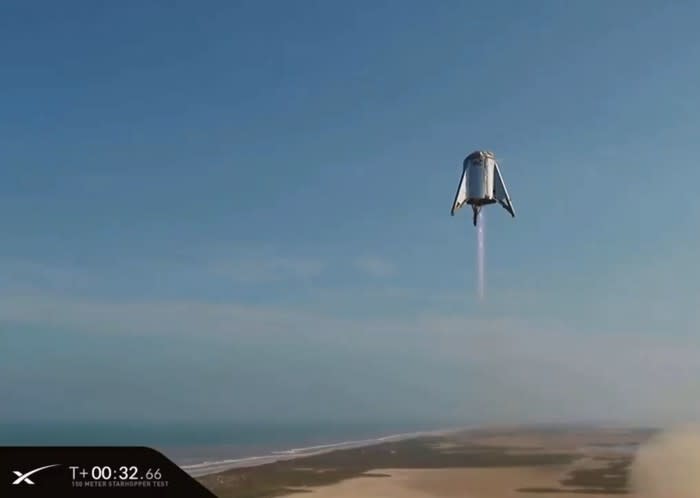SpaceX Starhopper Takes a Giant Leap
First, there was Grasshopper.
Then came the Falcon 9 "flight-proven" rocket. Then the Falcon Heavy. Now, Elon Musk's SpaceX is working on the latest iteration of its reusable rocket concept -- the "Starship."
Earlier this week, SpaceX completed the last of four test flights of a smaller prototype of the massive Starship spacecraft that he hopes to one day use to colonize Mars. The test bed in question, dubbed "Starhopper," had previously fired its new Raptor engine twice while tied down to the ground, and then a third time -- untied this time -- saw Starhopper lift 20 meters into the air before settling back to Earth.
On Tuesday, Starhopper beat that record by a factor of 7, first flying to 150 meters altitude, then side-slipping 100 meters away from its launch site before settling back down on a nearby landing pad. The entire test flight comprised a mere 57.36 seconds.
But that was enough to convince SpaceX that it's now ready to move ahead on its next big thing.

Image source: Elon Musk.
What comes next
Why did SpaceX only test-fly Starhopper four times before deciding it's ready for prime time? Probably because, seven years after it began its foray into the realm of reusable rockets, SpaceX has the mechanics of launches and landings down pat. Starhopper's tests were done simply to confirm that what has worked so well for Falcon 9 and Falcon Heavy over the past several years will continue to work just as well when scaled up to a much larger launch vehicle.
And Starship will be much larger.
The Starhopper test bed is as big as (and bears an uncanny resemblance to) a municipal water tower, measuring nine meters in diameter and standing 20 meters tall. Starship proper will be about three times larger -- 9 meters by 55 meters. And when mated with a Super Heavy booster to lift it into orbit, Starship should measure some 9 meters in diameter and stand nearly 120 meters tall. Combined, the two pieces of what Elon Musk once called his "Big Falcon Rocket" will comprise the largest, most powerful rocket ever built -- even bigger than the Saturn V that propelled humanity to the moon 50 years ago.
(Inspired by Elon Musk's post-Starhopper-test tweets, some analysts are predicting SpaceX will eventually upgrade to a "Starship 2.0" rocket with a diameter 50% greater, and a height of perhaps 240 meters, Super Heavy 2.0 included).
In the meantime, two prototypes of Starship ("Mk1" and "Mk2") are currently under production -- one in Boca Chica, Texas, and the other in Cocoa, Florida. Each reportedly sports three Raptor engines to power it, as compared to the single Raptor that powered Tuesday's test. But more engines could be added before the spacecraft fly. Production versions of Starship are expected to be equipped with at least six Raptor engines each -- and the Super Heavy booster could sport as many as 35!
Speaking of those Raptors, in tweets following the successful Starhopper test Tuesday, Elon Musk confided that SpaceX will have Starship's engines ready to try an orbital launch in "probably 2 to 3 months." By then, at least the Mk1 Starship will already be assembled and ready to receive the new engines.
And while plans may change (SpaceX intends to issue an update on its timeline on Sept. 28), right now, the plan is to attempt a 20-kilometer suborbital launch and landing in October, followed by an orbital attempt before the end of 2019.
Aiming for 20km flight in Oct & orbit attempt shortly thereafter. Starship update will be on Sept 28th, anniversary of SpaceX reaching orbit. Starship Mk 1 will be fully assembled by that time.
— Elon Musk (@elonmusk) August 28, 2019
Why all of this is important
At this point it bears reminding: As exciting as all this new technology may sound, SpaceX is still not a public company, so you can't yet invest in it (except for in just one roundabout way). But neither should you ignore SpaceX -- and for two key reasons.
First: The moon. Right now, several space companies -- actually, pretty much everyone who is anyone in space, from heavyweights like Boeing and Lockheed to Northrop Grumman and Aerojet Rocketdyne, is working feverishly to get NASA's vaunted Space Launch System ready to fly. Delays and cost overruns on the $35 billion project abound, however, and at last report, government regulators were saying SLS might not launch before 2021.
By that time, SpaceX's cheaper, bigger, more powerful Starship may have been already flying for more than a year. In which case, it's entirely possible the government will pull the plug on SLS -- and the SLS revenues these several companies were expecting to receive, could evaporate.
Second: Profits. Companies -- even those as seemingly magical as SpaceX -- need profits to survive. Successful as SpaceX has been at winning business, however, it's not believed to be very profitable, or even profitable at all, right now. It's counting on the deployment of a Starlink system of orbiting broadband satellites to generate the profits that will fund future endeavors such as a mission to Mars, and has already begun launching satellites for the network.
The sooner SpaceX gets a critical mass of Starlink satellites into orbit, the sooner it will generate profits.
And the sooner it gets Starship operational, the sooner it will get those Starlink satellites into orbit.
Based on what we saw earlier this week, this could all happen very soon indeed.
More From The Motley Fool
Rich Smith has no position in any of the stocks mentioned. The Motley Fool has no position in any of the stocks mentioned. The Motley Fool has a disclosure policy.
This article was originally published on Fool.com
